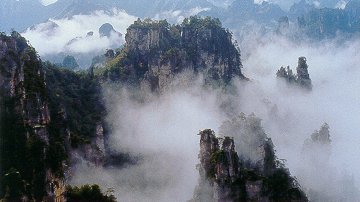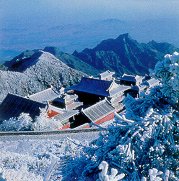| Contents
66.2 The Philosophy of Hua-yen Sect 66.3 Doctrine of Dharmadhatu 66.4 Non-obstruction and Totality 66.5 Mutual Penetration and Mutual Identity 66.6 Fa-tsang𠏋 Hall of Mirrors
66.1 Five Divisions and Ten Schools Hua-yen sect formulated a complete doctrine embracing all the aspects of Buddhist teachings, and can be classified into Five Divisions and Ten Schools ( 五教十宗 ).
The Five Divisions are further separated into ten schools, namely:

66.2 The Philosophy of Hua-yen Sect Hua-yen sect attempted to formulate a complete doctrine embracing all aspects of Buddhist teaching. Based on the Avatamsaka Sutra, Hua-yen's doctrine emphasizes the mutual identity and inter-dependence of all phenomena, which are usually called 'Shih' ( 事 ) in Hua-yen's terminology. In other words, all things are inter-related and mutually dependent for their empirical and concrete existence. In Buddhism, it is said that the existence is conditional, or it is known as the characteristic of impermanence or emptiness. However, like Tian-tai sect, they are identical in nature, as they have same self-nature in Dharmahadtu (i.e. Dharma realm -- to be elaborated later ). The self-nature is usually called 'Li' ( 理 ) in Hua-yen terminology. The idea of the self-nature is somewhat like the Noumenon, the Absolute, Buddha Nature, True Suchness, Tathagataghaba, etc. While retaining their own absolute nature, all phenomena nevertheless are subject to conditions and degenerate into the form of the conditioned, impure and mundane world. (The concept of 'Li' and 'Shih', and its relationship will be elaborated in section 67.2.) Therefore, each part is dependent on the whole, and at the same time, contributes to the whole. All phenomena are the manifestation of one immutable noumenon, and they are in perfect harmony with each other, like the different waves of the same water. These are the concepts of Totality and Non-obstruction in Hua-yen sect. It is also called Dharmadhatu Dependent Arising, which will be discussed in detail later. 66.3 The Doctrine of Dharmadhatu What is Dharmadhatu? It is usually translated as 'realm'. A realm is defined as a territory, sphere, or domain, within which certain activities and thoughts take place according to certain criteria. A realm has its own boundaries or frame of reference under designated conditions. Taking water as an example, ordinary people see water as a liquid for drinking. However, chemists see water as a compound of oxygen and hydrogen; philosophers see water as a matter of causation, etc. In Buddhism, water is just a name given to one of the manifestations of Dharma nature, or the outflow of supreme Buddhahood / True Suchness. Thus, the functions of water may vary when the frame of reference is set in different ways, or when it is viewed from different perspectives. There are many realms within one single object, say water. However, it should be noted that each of the realms has its own activities for water, yet all the realms can exist simultaneously. This leads to one of the important concepts in Hua-yen sect -- the Doctrine of Simultaneous Arising ( 同時俱起 ) Moreover, these realms do not obstruct or interfere with each other, and mutually penetrate one another in harmony. This leads to another important concept in Hua-yen sect -- the Doctrine of Simultaneous Non-obstruction ( 同時無礙 ). 66.4 Non-obstruction and Totality The theme of Hua-yen philosophy hinges upon the concept of Dharmadhatu. However, the concept of Non-obstruction and that of Totality are the most significant characteristics in Dharmadhatu.
Non-obstruction, in Hua-yen's doctrine, has a broader meaning of 'boundary wall', because the 'walls' can be intangible, abstract and submissive, yet they have a definitely restricting or limiting function. For ordinary people, they have to break through the 'walls' in order to shift from one realm to another. As they use to do and think from one particular viewpoint or in a designated framework in the mundane world, they may require great effort and patience, insight and wisdom to break through the 'walls' or remove the 'blockages'. A complete removal of the 'blocking walls' in the way of Totality will enable one to reach the realm of Non-obstruction, which are again the goal and the core of Hua-yen. The concept of Non-obstruction is developed from the doctrine of Emptiness, because only the Emptiness has no boundary wall by itself, thus no obstruction at all. One should have a thorough understanding of the doctrine of Emptiness in order to realize the truth of Non-obstruction. 66.5 Mutual Penetration and Mutual Identity The Hua-yen philosophy can be summarized in two basic principles, namely the Principle of Mutual Penetration and the Principle of Mutual Identity. The former corresponds to the Principle of Dependent Arising that all things depend upon one another for their existence (and functions) and extinction. In Hua-yen's doctrine, it has a broader meaning, such as simultaneously mutual arising, simultaneously mutual entering, and simultaneously mutual containment. The latter is almost an equivalent of the Heart Sutra's dictum that 'Form is Emptiness, and Emptiness is Form'. They are mutually identical, and in compliance with the Principle of Non-duality. Based on these theories, Hua-yen doctrines create the most magnificent scale in the cosmic world:
66.6 Fa-tsang's Hall of Mirror In order to help Empress Wu Tse-tien ( 武則天 ) to understand the principle of totality, the great master Fa-tsang led her into a room lined with mirrors. He fixed the huge mirrors on all four walls, on the ceiling and the floor, all facing one another. He then placed a statue of Buddha at the center of the room with a candle beside it. The Empress was immediately inspired, and managed to visualize the Principle of Totality and the principle of Non-Obstruction. With the infinite inter-reflections among all the mirrors, the Buddha's images are found in the reflections in each mirror for all other mirrors, together with the specific Buddha's image in each particular one, which are also found in turn in every reflection of any other mirror. It demonstrates the Principle of Mutual Penetration and the Principle of Mutual Identity.
|



 Non-obstruction
can generally be defined as the complete freedom from all bindings,
and the infinite possibilities of interpenetrations among the realms,
despite of the variations in space and time. Totality can generally
be defined as all-embracing and all-merging aspects of all realms.
The two concepts can be applied to Buddha-nature.
Non-obstruction
can generally be defined as the complete freedom from all bindings,
and the infinite possibilities of interpenetrations among the realms,
despite of the variations in space and time. Totality can generally
be defined as all-embracing and all-merging aspects of all realms.
The two concepts can be applied to Buddha-nature.